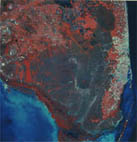|
Introduction to the South Florida Project |
|
Dr. Brian F. Glenister supervising the sorting of samples. |
|
History of Project: 1) Dr. Glenister of the University of Iowa had a 40 year involvement in the project through lectures, lab work, and field trips. He worked with University of Iowa students, oil explorationists (especially AMOCO), and governments (U.S., Russia, etc.) to gather and analyze geologic and paleontologic data from the South Florida Area. 2) Each year petroleum explorationists gathered with 25 other participants for a week in Florida to work on the project. 3) AMOCO invested 1.5 million dollars into the South Florida Area project in order to train new geologists and to gain geologic knowledge that they could apply to their oil exploration. The University of Iowa Paleontological Repository houses the collections and database. |
|
Objectives of the Florida Bay Project: 1) Enjoy the attractive and colorful shells.2) Obtain familiarity with clams, snails, and a little bit about associated plants and animals. 3) Sharpen the ability to differentiate species. 4) Recognize patterns (trends) laterally and vertically in community structure (i.e. size, abundance, and diversity). 5) Demonstrate logic with predictability of lithofacies and biofacies. 6) Learn economic implications of facies analysis: recognition of source and reservoir beds is critical when single wells can cost $5-50 million. |
|
Field Procedures: Field work began by arriving at a locality (sometimes by boat or helicopter). First, samples were collected from the surface sediments by a pipe dredge or shoveling. Core samples were also taken from some localities. The shovel samples were sifted to reduce the amount of mud, and then the samples were prepared for transport to a lab where they would be further analyzed. Small cores were shipped to the lab in one piece, while larger cores were cut into many pieces for transportation. Water samples were also collected from the localities so that water tests such as salintiy could be conducted. These data helped to analyze current and past depositional environments. Lastly, the collected sediments were dated by sending peat samples from the cores to be carbon-14 age dated. |
Field photographs from the South Florida Project
| A satellite image of the South Florida area.
(From Dr. Brian F. Glenister's Slide Collection) |
|
|
An aerial photograph of the South Florida reef
area. (From Dr. Brian F. Glenister's Slide Collection) |
| Another method of gathering samples.
(From Dr. Brian F. Glenister's Slide Collection) |
| Boats were commonly used to collect samples.
(From Dr. Brian F. Glenister's Slide Collection) |
|
|
Recording shell diversity.
(From Dr. Brian F. Glenister's Slide Collection) |
| Samples are shoveled into a bucket.
(From Dr. Brian F. Glenister's Slide Collection) |
| Mud being sieved to facilitate study of shells.
(From Dr. Brian F. Glenister's Slide Collection) |
|
|
Many of the shells were sorted in the field, as shown
in this photograph.
(From Dr. Brian F. Glenister's Slide Collection) |
| Geologists drilling a core sample.
(From Dr. Brian F. Glenister's Slide Collection) |
|
|
Preparing to drill another core sample.
(From Dr. Brian F. Glenister's Slide Collection) |
|
|
Drilling a core sample.
(From Dr. Brian F. Glenister's Slide Collection) |
|
|
Cutting and analyzing a core sample.
(From Dr. Brian F. Glenister's Slide Collection) |
|
|
More cutting and analyzing of the core samples.
(From Dr. Brian F. Glenister's Slide Collection) |
|
|
A displayed core sample.
(From Dr. Brian F. Glenister's Slide Collection) |
|
|
Another section of the core sample.
(From Dr. Brian F. Glenister's Slide Collection) |
Return to South Florida Biofacies Project Home Page
Click here for Dr. Brian F. Glenister's department webpage
Last updated on 28 July 2004 - has















